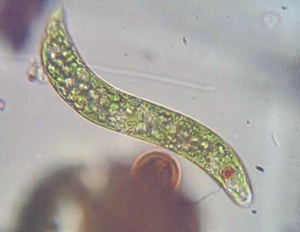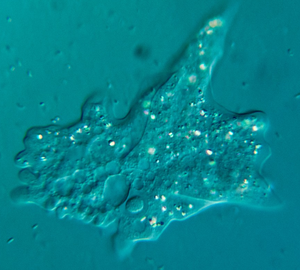Difference between revisions of "Protist"
| Line 1: | Line 1: | ||
==Key Stage 4== | ==Key Stage 4== | ||
===Meaning=== | ===Meaning=== | ||
| − | A '''protist''' is a [[unicellular]] [[Eukaryotic Cell|eukaryotic]] [[organism]] with a [[Cell Membrane|cell membrane]], [[Cell Wall|cell wall]], [[cytoplasm]], [[mitochondria]], and a [[Nucleus (Biology)|nucleus]] | + | A '''protist''' is a [[unicellular]] [[Eukaryotic Cell|eukaryotic]] [[organism]] with a [[Cell Membrane|cell membrane]], [[Cell Wall|cell wall]], [[cytoplasm]], [[mitochondria]], and a [[Nucleus (Biology)|nucleus]] and may also contain [[chloroplast]]s. |
| + | |||
| + | ===About Protists=== | ||
| + | : '''Protists''' are sometimes called '''protoctists'''. | ||
| + | : Two '''protists''' you may know are; [[amoeba]] and [[euglena]]. | ||
| + | |||
| + | ===Examples=== | ||
| + | {| class="wikitable" | ||
| + | |- | ||
| + | |[[File:Euglena.png|center|300px]] | ||
| + | |[[File:Amoeba.png|center|300px]] | ||
| + | |- | ||
| + | | style="height:20px; width:300px; text-align:center;" |A [[euglena]] is a type of '''protist''' with [[chloroplast]]s and a [[flagellum]]. | ||
| + | | style="height:20px; width:300px; text-align:center;" |An [[amoeba]] is a type of '''protist''' which moves using [[pseudopodia]] and has no [[chloroplast]]s. | ||
| + | |} | ||
Revision as of 11:40, 3 June 2019
Key Stage 4
Meaning
A protist is a unicellular eukaryotic organism with a cell membrane, cell wall, cytoplasm, mitochondria, and a nucleus and may also contain chloroplasts.
About Protists
Examples
| A euglena is a type of protist with chloroplasts and a flagellum. | An amoeba is a type of protist which moves using pseudopodia and has no chloroplasts. |

